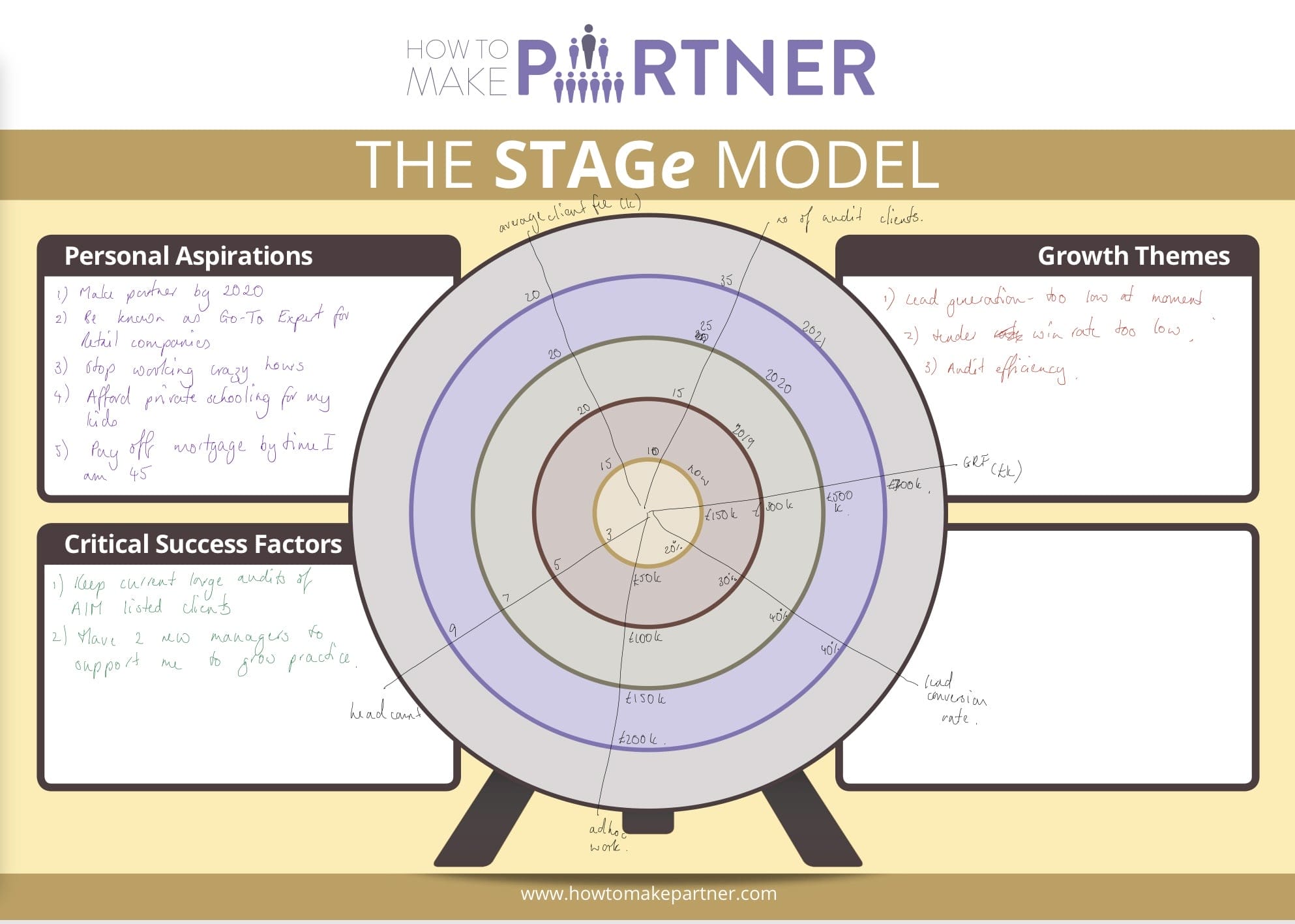One of the partner business plan tools we use with our small firm clients is the STAGe model. This is widely used to create 3-year or 12-month business plans for them. The good news is that it is versatile enough to help you create your 3-year partner business plan or 12-month partner business plan or vision for your practice. In this article ,I explain how to use the tool, plus you can download a template to create your 3-year partner business plan or 12-month partner business plan for your own practice.
What does the tool enable you to do?
The STAGe Tool is a one-page vision summarising your practice’s expected performance over the next 3 years or 12 months. It gives you a simple visual way to explain how your practice will develop in the future. In other words, it acts as a very simple, but highly effective tool to help you create your partner business plan – a key component of your business case for partner.
The tool consists of 5 circles that correspond to now, year 1, year 2, year (or the timescales of your choice.), or Q1, Q2, Q3, Q4. The circles are dissected by axes which represent the performance measures that best illustrate how your practice will develop. Each performance measure is broken down into what it will be at each year. This article assumes you are creating a 3-year partner business plan. However, you can also use the same template to create a 12-month partner business plan.
Click here to download your free PDF of the STAGe model to help you rapidly put together your partner Business plan.
Here is a completed STAGe tool:

Stage 1: Envision the future
Take a moment to think about where you want your practice to be in 3 years if you are successful at the partnership vote. (Or 12 months if you are being asked to create a 12-month partner business plan) You may find it useful to do this exercise away from your desk and distractions.
You may like to consider the following areas:
Clients
- Type?
- How many?
- Average spend?
- Services offered?
- Key accounts won? Or were panels appointed too?
Financials
- Revenue and/or GRF?
- Key metrics which are important for your firm, e.g. WIP, Lockup, utilisation?
- Contribution to the firm?
People
- Structure of your team/practice?
- Development required?
Business Development
- No. of leads required a month?
- Referrers needed?
- Sectors/markets/Niche to target?
Read: What needs to go in the 12-month marketing plan for your business case for partner
a
Stage 2: Identify the really important metrics or things for your practice

In stage 2, you identify what are the really important things for you and your practice. Those things that if you focus on them you will achieve your 3-year. These then become the axes on your STAGe diagram. Ideally, you will identify 8-12 measures of performance to accurately show how you will grow your practice in the next three years.
One of the most sought-after courses in our Progress to Partner Academy is called “How to Build a Cast-Iron Business Case for Partner”.It’s a must-have in your arsenal of tools and guidance to help with your career progression. There is also a section in Progress to Partner Academy on the Partnership Admissions process with guides and recordings to help you find your way through the system. Check it out!
a
Stage 3: Identify your year 3 performance measures
Now take the STAGe template and label your performance measures and name the years on the concentric circles. For each performance, measure the axis and add what you are currently achieving. You now want to define your year 3 performance measures. By defining year 3 first you can then work backward towards your 12-month targets.
It can be very helpful to start the year 3 discussions by considering the fundamental financial measures for your practice such as revenue, GRF, turnover, profit, or contribution. This is because they are normally easier to complete, and it often sets the agenda for the rest of the performance measures.
Stage 4: Identify year 1 and 2 performance measures
Once you have completed your year 3 performance measures you then want to work along each of the performance measures axes to complete year 1 and year 2 goals. You may like to use questions such as:
“If I am to achieve this level of performance in year 3, what level should I achieve in year 2?”
Then…
“If I am to achieve this level of performance in year 2, what do I need to achieve in year 1? Is this too big a stretch from where I am now?”
At the end of this stage, you should have a fully completed diagram with each performance measure having a number or statement for each year on the diagram.
Stage 5: Critically review your partner business plan

Now you have completed the partner business plan, it is time to critically review it. That means:
- Are the targets really feasible? Do the numbers stack up and relate to each other?
- Is it stretching enough? Or could you easily achieve more?
- Have you missed anything? Is anything really obvious? Any blind spots?
If you haven’t already click here to download your free PDF of the STAGe model to help you rapidly put together your partner Business plan.
Now what?
Once you have completed your partner business plan, it’s time to get feedback on it, plus identify the projects or activities which are critical to achieving your year 1 targets.
For more guidance on how to progress your career in your firm why not sign up to my weekly newsletter here and you’ll find out what you need to be working on in your career development (and how to make the time for your career development) to progress your career in your firm.
a
Or Check out our How to Build a Cast-Iron Business Case for Partner self study course.
✔️ What makes a good Business Case for Partner
✔️ 5 things you need to consider so the partners take notice of you
✔️ What needs to go into your 12-month business development plan








